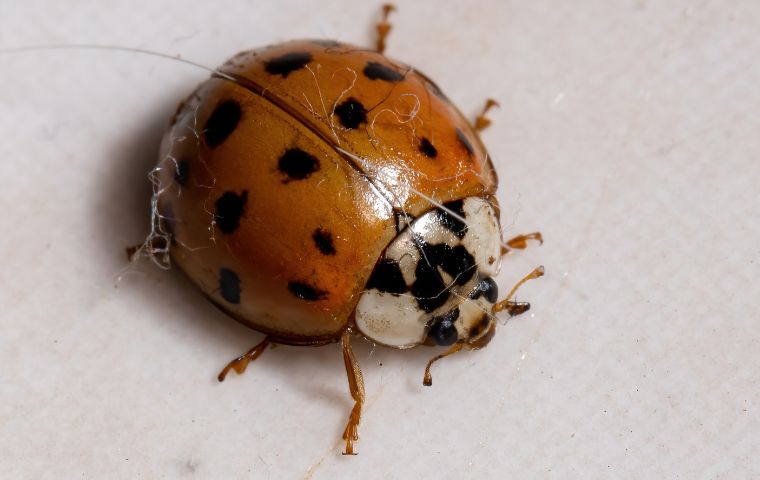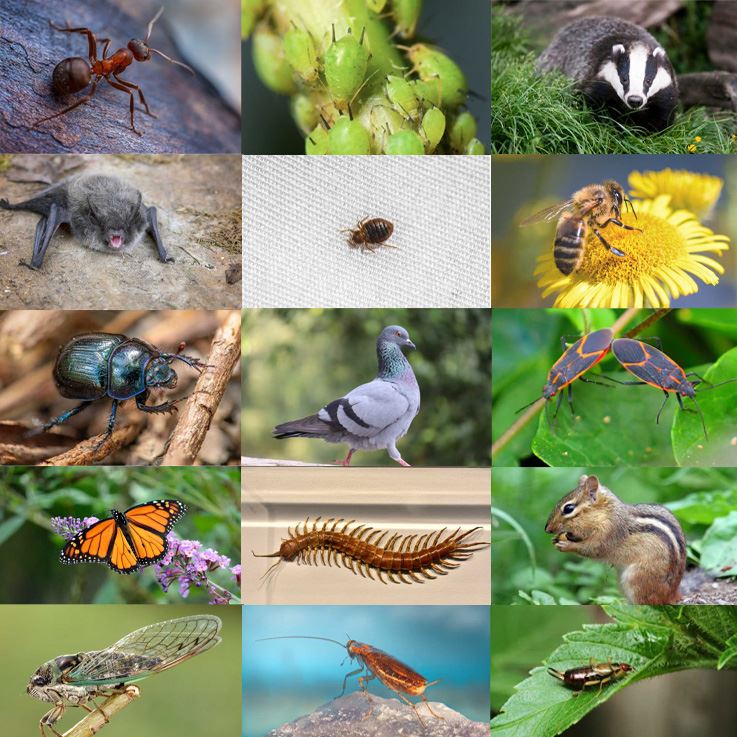
Asian Lady Beetles
What Are Asian Lady Beetles?
Asian lady beetles (Harmonia axyridis) are a species of ladybug that is native to East Asia but has become widespread in many parts of the world, including North America and Europe. While these beetles are generally considered beneficial insects due to their role in controlling pest populations, they can also become problematic under certain conditions.
Are Asian Lady Beetles Harmful?
Asian lady beetles (Harmonia axyridis), though beneficial in controlling pests like aphids, can also be considered harmful in several ways, particularly when they invade homes. Here are some of the ways they can be problematic:
- Invasion of Homes and Buildings: Asian lady beetles are notorious for seeking shelter in the fall, when temperatures drop, and they often invade homes, especially in large numbers. They tend to gather in clusters on warm, sunny sides of buildings, entering through small cracks and gaps around windows, doors, and vents. Once inside, they can become a nuisance, crawling on walls, ceilings, and even furniture. The sheer number of beetles can be overwhelming, causing discomfort for residents.
- Allergic Reactions and Health Concerns: Asian lady beetles produce a chemical substance in their bodies that is used as a defense mechanism when they are threatened. This substance is a yellow, oily fluid, which can cause allergic reactions in some people. Symptoms may include skin rashes, respiratory issues, or more severe allergic responses, particularly when individuals are exposed to large numbers of beetles. The fluid may also stain furniture and fabrics, adding to the inconvenience and damage caused by their presence.
- Potential for Destruction of Stored Products: In some cases, Asian lady beetles are known to invade food storage areas, contaminating products. Their presence in stored goods, such as grains or dried fruits, can make them unsuitable for consumption. While this is not a widespread problem, it can become an issue in certain situations, particularly when there is a large infestation.
Asian Lady Beetle Appearance
Asian lady beetles (Harmonia axyridis) are small, round or oval-shaped beetles with a distinctive appearance. Here are their physical characteristics:
- Size: Asian lady beetles typically measure between 5 to 8 millimeters in length, making them relatively small insects.
- Coloration: One of the most notable features of Asian lady beetles is their variable coloration. They can range from yellow to red to orange. Some individuals may have a bright orange color, while others may appear more yellowish.
- Spot Pattern: Asian lady beetles usually have numerous black spots on their wing covers, also known as elytra. The number of spots can vary, and some individuals may have no spots at all, while others may have up to 19 spots. The number and arrangement of spots can be a distinguishing characteristic.
- Pronotum Marking: The area right behind their head, called the pronotum, often has a distinct white "M" or "W" shape, which is a key identifier for Asian lady beetles.
- Head and Antennae: Their head is black, and they have short, thread-like antennae.
- Body Shape: Asian lady beetles have a somewhat hemispherical or dome-shaped body, and their elytra cover their wings, providing protection. When at rest, their elytra meet along the midline and completely cover the abdomen.
- Body Texture: The elytra have a smooth and shiny texture.
- Legs: They have six legs, like all insects, which are typically black.
The appearance of Asian lady beetles can vary somewhat among individual beetles, especially in terms of color and spot patterns. These variations have contributed to their common name as "ladybugs" due to their resemblance to native ladybug species.
Asian lady beetles are small beetles with variable colors, distinctive black spots on their wing covers, and a white "M" or "W" shape on their pronotum. Their overall appearance can be similar to that of native ladybugs, making proper identification important when distinguishing between the two.
Learn more: Asian Lady Beetles vs Ladybugs
Asian Lady Beetle Habitat
Asian lady beetles (Harmonia axyridis) can be found in a variety of habitats, and their presence may depend on the season and geographical location. Here are some common places where you might encounter Asian lady beetles:
- Agricultural Fields: Asian lady beetles are beneficial insects in agriculture, as they feed on aphids and other crop-damaging pests. Therefore, you can often find them in fields and gardens where their primary food sources are present.
- Gardens and Orchards: These beetles are commonly found in gardens, orchards, and other areas with abundant plant life. They are particularly attracted to areas where aphids and scale insects are feeding on plants.
- Residential Areas: Asian lady beetles sometimes find their way into residential neighborhoods, especially during the fall and winter. They may seek shelter in and around homes, including cracks and crevices, and can often be found near windows, doors, and light sources.
- Forests and Woodlands: In wooded areas, you may encounter Asian lady beetles, especially in locations with a mix of deciduous and coniferous trees. They may overwinter in tree bark crevices and leaf litter.
- Grasslands and Meadows: These beetles are also known to inhabit grassy areas and meadows, particularly in regions where aphids and other small insects are present.
- Overwintering Sites: In colder regions, Asian lady beetles have a tendency to aggregate in large numbers in overwintering sites during the colder months. This behavior can lead to them congregating in attics, wall voids, and other sheltered spaces in homes, as well as in natural overwintering sites such as caves, cliffs, and rock outcrops.
The presence of Asian lady beetles in residential areas can sometimes be more of a nuisance, as they may enter homes in search of shelter during the fall and winter. Homeowners often encounter them indoors during these seasons.
Learn more: What You Ought To Know About The Invasive Asian Lady Beetle
Asian Lady Beetle Diet
Asian lady beetles (Harmonia axyridis) are voracious predators that play a crucial role in agricultural and garden ecosystems by feeding on a variety of soft-bodied insects and aphids. Here's are some of the primary food sources for Asian lady beetles:
- Aphids: Aphids are one of the main food sources for Asian lady beetles. These small, sap-sucking insects are abundant in gardens and agricultural fields and can cause damage to plants. Lady beetles help control aphid populations by consuming them.
- Scale Insects: Scale insects are another common target for Asian lady beetles. These pests feed on plant sap and are often found on leaves and stems. Lady beetles feed on them at various stages of their development.
- Mealybugs: Mealybugs are soft-bodied insects covered in a white, waxy substance. They are a preferred food source for lady beetles and are often found on ornamental plants and crops.
- Whiteflies: Whiteflies are small, flying insects that feed on plant sap. Asian lady beetles are known to prey on whitefly nymphs and adults.
- Spider Mites: Asian lady beetles are effective predators of spider mites, which are notorious for damaging crops by piercing plant cells and sucking out their contents.
- Other Soft-Bodied Insects: While aphids, scale insects, mealybugs, and whiteflies are primary targets, Asian lady beetles may also consume other soft-bodied insects, such as psyllids, leafhoppers, and thrips.
Asian lady beetles are opportunistic predators, and their diet can vary depending on the availability of prey. Their role in controlling these pest populations makes them valuable to farmers and gardeners as natural biological control agents. However, it's important to note that when their primary food sources become scarce, especially during the fall and winter, these lady beetles may enter homes and structures in search of shelter, which can lead to human-lady beetle interactions.

Asian Lady Beetle Life Cycle
The life cycle of Asian lady beetles (Harmonia axyridis) is similar to that of many other ladybug species and can be divided into several distinct stages. Here is their life cycle:
- Egg Stage: The life cycle of Asian lady beetles begins with the female laying clusters of tiny, yellow, elliptical eggs on the undersides of leaves near aphid colonies and other potential food sources. The eggs typically hatch within a few days, depending on environmental conditions.
- Larval Stage: After hatching, the larvae emerge. Asian lady beetle larvae are elongated, somewhat flattened, and spiny in appearance. They are voracious predators, feeding on aphids and other soft-bodied insects. During this stage, they go through several molts, shedding their exoskeletons as they grow. The number of molts can vary, but it's typically about four. The larval stage can last from a couple of weeks to several weeks, depending on the availability of food and environmental factors.
- Pupal Stage: When the Asian lady beetle larvae have reached a sufficient size and have stored enough energy, they undergo pupation. During this stage, they attach themselves to a substrate and transform into pupae. The pupa is immobile and resembles a tiny, stationary, and somewhat translucent version of the adult beetle. Inside the pupa, the larval tissues reorganize to form the adult structures. The pupal stage usually lasts about a week.
- Adult Stage: After completing the pupal stage, the Asian lady beetles emerge as adults. They are now fully developed and resemble the characteristic shape and coloration of their species. Adult Asian lady beetles are capable of flight and are primarily active during the warmer months of the year. They feed on aphids, scale insects, and other soft-bodied insects, making them valuable predators in agricultural and garden environments.
- Reproductive Stage: Once they have reached adulthood, Asian lady beetles begin mating, and the cycle starts again as females lay eggs in suitable locations, typically near their primary food sources.
The timing of these life cycle stages can vary depending on environmental factors, such as temperature and food availability. Additionally, Asian lady beetles, like many ladybug species, often enter a period of dormancy or overwintering during the colder months, seeking shelter in natural and human-made structures until spring, when they become more active again.
Understanding the life cycle of Asian lady beetles is essential for managing their populations and using them effectively as biological control agents in agriculture and gardening.

Hear From Our Happy Customers
-
"Fantastic & Patient"
Jarvis was fantastic and patient. He answered my questions with an in-depth explanation and addressed all of my areas of concern. Would love for him to be my assigned tech going forward. Well done!
- Yonnette M. -
"Great Communication"
Tech was on time, communication was great, and he accommodated my needs.
- Alonzo W. -
"Very Knowledgeable"
The tech that arrived was courteous, professional, and very knowledgeable. He was Great.
- Uerial I. -
"Professional & Considerate"
I’m pleased with Miche services. Jarvis came today. Professional and considerate. Thank you!
- Judy B. -
"Wonderful Service"
Wonderful service. Jarvis is great. Took care of everything I needed. Thank you!
- Henry P. -
"Exceeds Expectations"
I can’t say enough positive things about this company... The tech that came out, Jarvis went above and beyond my expectations. Thank you guys, I will continue using your services.
- Jake M.



